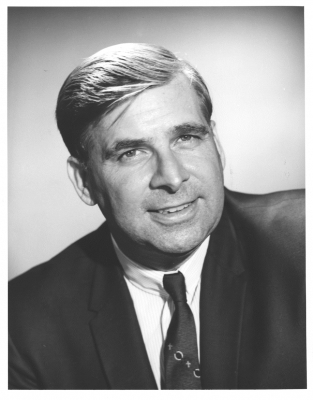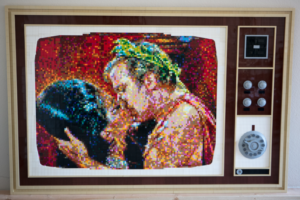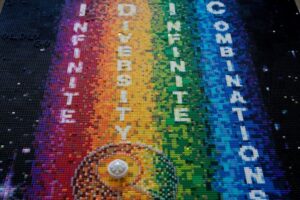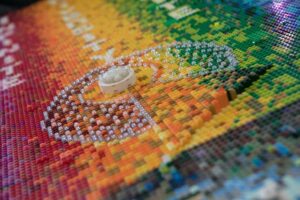On this special edition of EMExlclusives, today marks the 100th Birthday of a man who would change the way we dreamt about our future. Born on this day, one hundred years ago in El Paso, Texas – this visionary would launch a new sci-fi series on NBC nearly fifty-five years that taken audiences to strange new worlds and seek out new civilizations. With his unique vision, we still boldly go into the wonderful universe that is Star Trek. The man – was Gene Roddenberry!
While Gene has left us nearly thirty years ago, his vision still lives on! This year, Star Trek is still going strong. Don’t believe me, ask the thousands of Trekkies who descended to Vegas for the annual Creation Con this past weekend or the one who waited for the premiere of the second season of Lower Decks. No matter who you are or where you are in the world, Star Trek is alive and well. With three current series (Discovery, Picard and Lower Decks), one coming soon to Nickelodeon (Prodigy) and one new series just wrapped shooting its first season (Strange New Worlds), Roddenberry Entertainment CEO/Executive Producer and son of the legendary creator, Rod Roddenberry joins me for this exclusive interview!
Its an honor to talk with you Rod! My first question is that we are coming up on the Centennial Celebration of your father’s birth with #ThinkTrek and it includes #TalkTrek, #SeeTrek, #BeTrek and #MakeTrek. I want you to tell us about these hashtags and how does it relate to the centennial celebration.
Well, I will start with the fun part about it. You know the main ideal to get people engaged and so far its been fantastic because the images are so spectacular but anywhere in the world that just reminds you of Star Trek, it could a sign that you seen in the distance that has something to do with humanity, Vulcans or wherever the case maybe, it could be a stain on your desk that looks like the Enterprise or a cloud in the sky that looks like the Delta insignia. Whatever it is that speaks to you and reminds you of Trek, we want you to take photo of it take video of it and post it with the #ThinkTrek.
Underneath that umbrella of #ThinkTrek, for example #MakeTrek, Samuel Hatmaker who was on Lego Masters during Season 1, he is incredibly talented. We connected with him and he does these incredible mosaics of luminaries in the industry and all over the spectrum. We asked if he be willing to do something Star Trek, something that could capture not only the Star Trek people but the messaging and the feel. In the end, he came up with four but there will be five beautiful mosaics we have here in the Star Trek convention in Las Vegas. And they are not just mosaics of images, one is he captured the scene of Kirk and Uhura kissing on a classic 1960’s television frame.
Wow….
He has done another one which is IDIC, which is the definitely principle of Star Trek which stands for Infinite Diversity in Infinite Combinations and it’s got a rainbow behind it that is very similar and reminiscent to the Star Trek: The Motion Picture poster and for those you know Trek the message is that he appreciation of everything that is unique and different in the world and not just the appreciation but the thirst and craving from unique ideas and that is what allows us to grow and evolve.
And he’s got another one of my father and because we are celebrating his 100th and he is the man behind Star Trek, the man behind the ideology of Star Trek, this one’s about five feet tall. It’s a traditional mosaic image of him and it says “Boldly Go” but within this image he has put a Borg Collective, an IDIC symbol, Nurse Chapel among the fifty-five elements for the fifty-five years of Star Trek. Fifty-five Easter Eggs. So, when you get up and start looking, you will find George & Gracie. All of these elements are inlayed to it. I feel it is a masterpiece. Its one of a kind and its spectacular. The other ones are amazing, too.
Now we can say that Star Trek is in its peak with the shows of Discovery, Picard, Lower Decks just launched its second season, Prodigy coming to Nickelodeon and Strange New Worlds just wrapped its production of its first season. How you ever felt the Star trek has reached the pinnacle of its success fifty-five years on?
You know, as you were just saying that, I was thinking back to my father where he did the original series and pretty much after season two in his mind and in the studio’s mind that it was a bust. The ratings just weren’t there and it was a failure. And so, my father went through the ups and downs of Star Trek his entire career. Remember, Phase II was going to be a thing but that bombed and then they did the movie but that was considered a bomb. Then Next Generation came and it was going great and it started to skyrocket there along with Deep Space Nine, Voyager and Enterprise. And then that left the air.

I’m thinking back to Next Generation, my father would get on stage and he doesn’t do this very often but it’s a great little story where he gets up on stage and he folds his arms and he scans with his eyes and his smirk and he says “Yep, that’s the way I planned it”. It was his way of saying “How the hell did this happen? How did I go from the failed series in the ’60s to this critically acclaimed show right now that people are dying for?” As you said that we are now at that point where Star Trek is exploding. What I love about this Star Trek exploding is that it is exploding at such a diverse way that all three of the live action shows are very different. Very different in tone, very different in idea. Yes, they are in the same universe but even the two animated are very different but they are all within the same universe finally taking advantage of this vast vast Star Trek universe that exist.
Its amazing to believe how long we have come. Here you are at the big Star Trek con. I am wearing the Starship Farragut polo. We have Trek in its fruition through decade after decade after decade. You have had the chance of EP of these broadcast series but you have also stepped into the world of the fan films first as the consulting producer of New Voyages/Phase II and then you were a bridge officer in the Star Trek Continues episodes “Come Not Between the Dragons”. When you put on that uniform and stepped onto the bridge for the very first time, how does that feel for you? What goes through your mind?
Well, I am a terrible actor. I couldn’t act my way out of a paper bag. I didn’t do that because I wanted to be an actor, I just say “You got to make me a red shirt. I want to be on set and I want to be a red shirt in film.” And there’s actually a blooper reel where they did just that but to answer your question coming onto the set as a friend of the production, in both productions by the way, the amount of attention and love and caliber that they put into every detail. Researching the kind of panels that they put on the walls, the harsh lighting, the vivid colors. I was born in ’74, so I never got to see the original set but I definitely thought that this must have been what its like. Its really got to be what its like. And I was so impressed with the caliber of the crew. People who do must have truly loved it. There was so much attention to detail and time into this and love. So, I wanted to be part of it.
Fans have kept Star Trek alive for decades and this was another version of them keeping it alive. So, I couldn’t be prouder to be associated with any fan production that truly represents the Star Trek ideas and truly wants the Star Trek message to keep going.
You’re absolutely right. It was the show that my mom and I watched when I was a little kid. She was the one that took me to my very first convention. She also had taken me to the Trek exhibit at the National Air & Space Museum during its 25th Anniversary. I am forever grateful for what your father has created and I am forever grateful for you to keep in going.
Since 1966, Trek has broken barriers when it comes to inclusiveness. From Nichelle Nichols & George Takei in the Original Series to Sonequa Martin-Green & Michelle Yeon leading Discovery to Hanelle Culpepper who became the first African-American woman to direct the first episode of any Trek series and winning an NAACP award for her efforts. What have you seen from your involvement in Trek that we must keep up the inclusiveness and continue to break barriers? We just have the first transgender actors in a Trek series and making the language normalized and not stigmatized.
Yes, I loved that you said normalized. Star Trek has been known and is known for breaking these boundaries. It should be pushing these barriers and it should be doing it in a way that you just described, its normalized. You know, the crew onboard the original Enterprise, there was no issue. It’s just a crew of people working together. It didn’t matter what the skin color was or where they’re from or whatever their accent was and that’s what I love about Star Trek. You’re right, it still has to make people want to have the conversation, the dialogue has to continue.
So, whether it’s the two openly gay characters on Discovery and it doing it respectfully because we don’t want to beat the audience over the head. In Star Trek, we want to show it as normal. These aren’t two gay characters, these are characters in love and they’re sharing moments and showing you what its like. Now that makes certain people in this world uncomfortable and I’m thrilled that it does not because I would wish any harm to them intellectually or physically in any way whatsoever but it hopefully gets them to feel a certain way and perhaps have a dialogue and perhaps explore with their friends and ponder “What is wrong with this?” and “What is not wrong with this?” I am glad they are asking these questions that they are. Some people had had more time to live with that and it is normalized for us.
There was a fan way back that asked my father a question about a gay character asking “Why aren’t there any gay characters in Star Trek?” And sadly, the truth was the studio heads at the time and I am not making any excuse for Star Trek but there should have been gay characters represented back then. However, it didn’t happen at the time. My father gave this answer which was a copout but over the years I really grown to appreciate the answer. His response was “What are you talking about? There are tons of gay crewmembers on the Enterprise. You just didn’t see it. In the future, it’s a nonissue. You don’t need to have the stereotype of the rainbow flag and skipping down the hallway or whatever that is to you. There were gay characters on Star Trek. They had a job to do. They did their job and they have their loved ones. It didn’t matter who they were. It didn’t matter what gender. The Captain didn’t care who they were dating.” And that’s a beautiful version of a nonissue. Its all over the place. These people are showing unconditional love amongst the crew. It’s the goal but Star Trek needs to show it because we still need to have this message. And there are people out there who say “Star Trek is doing too much of this!” No, this is Star Trek’s job. It needs to do this but I’m sorry if it’s a little too much for you. And maybe, you’re already fine with gay characters. Maybe these issues aren’t an issue to you but there’s still lot of people that they are. So, the conversation still has to be had.
You have been focused on making the future of Star Trek a reality through the Roddenberry Foundation through advanced medical research in pluripotent stem cells. Can you give more information about your foundation and what has it achieved so far?
We started in 2010 and the ideal is to represent that Star Trek philosophy. By that, I mean we are working on the long-term advancement in our species, no band-aid solutions. One of the organizations that we founded was the Gladstone Foundation in San Francisco and we did almost a year of due diligence. They were one of the leaders in pluripotent stem cells research. In fact, they brought the Nobel Prize winning scientist Shinya Yamanaka where you can any adult cell and reverse engineer it into a heart, a liver or any other cell and start growing a batch of those cells. One of the first things with saw in a microcell was sheet of a beating heart cell that was taken from an adult male skin cell. The implications were huge. Even if right now we can’t grow organs, I mean hopefully that’s something in the future, what’s amazing about this is just to say that you have a heart condition they can start medicine on these tissues and get an accurate result. There are hundreds of medicines out there and some of them maybe detrimental to the patient. And instead of experimenting on the patient, they can put it on these heart cells and see how they respond.
There are tons of applications for this technology and for us it seems like this is definitely cutting edge, this is future technology. This is something that can and will have a huge impact on humanity one day. We wanted to partner up with them, contribute and hopefully grow their program which they have done over many years. Go to Roddenberryfoundation.com for more information


